Gas BBQ: Barbecue Gas Hose and Regulator for BBQ Gas Bottle
A BBQ gas gas hose and regulator assembly, for a gas BBQ, controls the gas regulator pressure from the BBQ gas bottle to the gas BBQ. The BBQ gas regulator screws directly onto the BBQ gas bottle valve whilst the BBQ gas hose is attached to the gas BBQ itself.
BBQ gas hose and regulator, for a gas BBQ, typically comes equipped with POL or LCC27 gas bottle gas fittings.
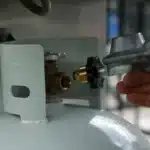 The image shows a gas regulator being inserted into the POL fitting of the propane BBQ grill gas bottle-tank valve.
The image shows a gas regulator being inserted into the POL fitting of the propane BBQ grill gas bottle-tank valve.
The BBQ gas hose and regulator assembly will deteriorate with age.
Replacing the BBQ gas hose and regulator every 5 years, or sooner if damaged, is good safety practice.
Always do a soapy water leak test every time you disconnect and reconnect your gas regulator to the gas BBQ.
Also inspect the rubber O-ring, if so equipped.
How Does a Gas Pressure Regulator Work – What Does a Gas Regulator Do?
A gas regulator works by reducing the gas regulator pressure from the gas bottles to the gas appliances.
The gas regulator does this automatically, reducing the gas regulator pressure to the required 2.75 kPa for LPG appliances.
Every gas BBQ requires a gas regulator.
The pressure within a gas bottle can be 800-900 kPa vs the 2.75 kPa gas regulator pressure required by LPG gas appliances.
A gas regulator work with a diaphragm, which is a flexible rubber disc that responds to pressure changes and functions to regulate the flow of gas at the proper gas regulator pressure.
The gas regulator diaphragm works in combination with springs within an LPG gas regulator.
A gas pressure regulator has a factory pre-set standard gas regulator pressure for gas appliances.
Gas regulator is sometimes referred to as cooking gas regulators, when working with cooking gas appliances.
Gas Regulator for Larger Appliances
You would need a larger gas regulator for gas logs, gas heaters or gas hot water systems.
A BBQ gas regulator does not have the capacity for larger gas appliances with higher MJ ratings.
Gas Regulator Problems
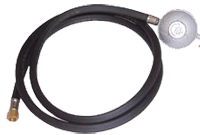 Gas regulator problems can occur as a gas regulator gets older.
Gas regulator problems can occur as a gas regulator gets older.
The gas hose can crack and perish from old age. The same is true of the rubber diaphragm.
Gas regulator problems also include a blocked vent, as the diaphragm works in conjunction with the gas regulator vent, which allows the diaphragm to move freely to provide the 2.75 kPa gas regulator pressure.
If the vent is obstructed, the diaphragm will not operate properly and you will have gas regulator problems.
You should use care to make sure it remains free of dirt and debris, to help avoid gas regulator problems.
Gas Regulator Leaking Gas
A gas regulator leaking gas requires immediate action.
You can check for leaks using the using the soapy water leak test.
Assuming it is connected properly, a malfunctioning gas regulator needs to be replaced, as it is a safety hazard.
A gas regulator can perish as it gets older.
A gas regulator is typically a sealed unit, so repairing one is rarely an option.
Gas Hose
A gas hose connects the BBQ gas regulator on one end, with a LCC27 or POL fitting, and the gas BBQ or gas outdoor heater on the other end.
These can become damaged or deteriorate with age.
You should visually inspect the hose for cracking, splitting or other damage.
It’s the gas coming from faulty hoses and connections that ignites and causes the vast majority of gas BBQ grill fires.
You should replace the hose if it shows any signs of damage or degradation.
It is good practice to replace the entire gas regulator and hose assembly, if it is old enough for the hose to have deteriorated, as gas regulators also wear with age.
O-Ring Seal
The standard BBQ gas regulator in Australia has a POL or LCC27 gas bottle fitting.
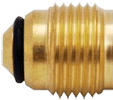 The male connector of the gas regulator, which screws onto the valve fitting on your gas bottle, may have a rubber O-ring seal or it may rely on a metal to metal contact seal.
The male connector of the gas regulator, which screws onto the valve fitting on your gas bottle, may have a rubber O-ring seal or it may rely on a metal to metal contact seal.
You should always inspect the gas regulator for damage, paying special attention to the connector, which screws into the gas bottle.
It should be clean and undamaged.
If it has a rubber O-ring, it also needs to be undamaged.
Gas Regulator Pressure
The LPG is stored under pressure as a liquid in your BBQ gas bottle.
It turns back into a gas when you release some of the pressure in the gas bottle by turning on your BBQ burners.
The LPG gas bottle pressure within a gas bottle can be 800-900kPa.
This varies based on the ambient temperature and exposure to the radiant heat of the sun.
However, the required appliance inlet gas regulator pressure for your gas BBQ is typically a 2.75kPa,
So, the gas regulator is required to reduce the LPG gas bottle pressure and ensure a consistent 2.75kPa gas bottle pressure is safely delivered from the gas bottle to your BBQ.
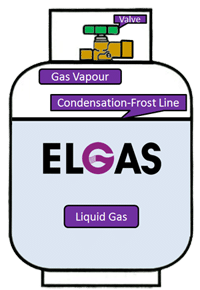 Ice on BBQ Gas Bottles and Regulators
Ice on BBQ Gas Bottles and Regulators
Under the right circumstances, condensation or ice can form on a gas bottle or regulator.
The faster the gas is used, the colder the gas regulator will get.
Depending on the humidity of the surrounding air and the rate at which the gas is being used, a condensation line, frost or even ice will form on the gas bottle or regulator.
Leak Testing
The BBQ gas regulator and hose assembly should be checked for leaks, using the soapy water leak test, every time you disconnect and reconnect the gas regulator to the BBQ gas bottle.
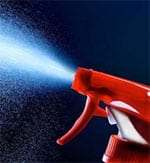 Put some soapy water in a spray bottle, turn on the BBQ gas bottle without turning on the gas BBQ, then spray the entire valve, gas regulator and hose assembly with the soapy water.
Put some soapy water in a spray bottle, turn on the BBQ gas bottle without turning on the gas BBQ, then spray the entire valve, gas regulator and hose assembly with the soapy water.
You would see bubbles or smell gas if there is a leak.
When done, rinse with clean water to remove the soap solution.
For more detailed instructions, please watch this short BBQ Gas Leak Test video (1:00)
Keep POL Fitting Clean
When the gas BBQ gas regulator is disconnected, it is important that you keep the POL fitting connector clean.
If you are going to leave the BBQ gas regulator disconnected for an extended period of time, it is a good idea to cover the end of the POL fitting connector with a small plastic bag to keep out dirt and insects.
This can prevent blockage problems later and may save you the expense of buying a new gas regulator.
Connecting & Disconnecting the Gas Regulator
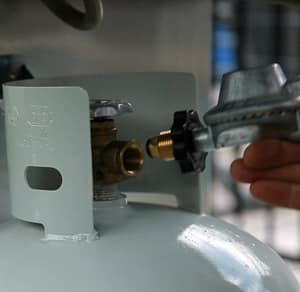 The male connector of a POL gas regulator has a reverse or left-handed thread.
The male connector of a POL gas regulator has a reverse or left-handed thread.
So, to detach the gas regulator from the BBQ gas bottle, you turn it clockwise and then anti-clockwise to re-attach.
The male connector of an LCC27 gas regulator has a normal right-handed thread.
So, to detach the gas regulator from the BBQ gas bottle, you turn it anti-clockwise and then clockwise to re-attach.
For full step-by-step instructions, please see:
How to Attach or Change Your BBQ Gas Bottle.
How to Prevent Gas BBQ Fires
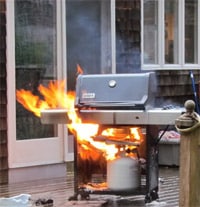 There has been a bit of news recently regarding gas BBQ fires.
There has been a bit of news recently regarding gas BBQ fires.
So, it’s worth taking the time to review gas BBQ safety.
The media is fond of reporting “exploding gas cylinders”.
The reality is that gas cylinders rarely explode.
In fact, it would be quite difficult to make one explode.
Pressure Relief Valve Protects You
Why is this?
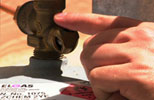 Well, gas bottle valves are equipped with pressure relief valves.
Well, gas bottle valves are equipped with pressure relief valves.
It’s like a valve within a valve.
If the cylinder is exposed to excessive heat, the pressure relief valve allows the gas to vent and keeps the LPG gas bottle pressure within safe limits.
The worst thing that can happen is the venting gas ignites and you have a plume of flame.
This will self-extinguish when the gas bottle runs out of gas.
This is why you always want to use your BBQ outdoors and away from your home or other flammable materials.
BBQ Gas Hose and Regulator — The Usual Suspects
 BBQ gas hose and regulator assemblies deteriorate with age and can start leaking.
BBQ gas hose and regulator assemblies deteriorate with age and can start leaking.
It’s the gas coming from these leaks that ignites and causes the vast majority of gas BBQ fires.
Some experts recommend replacement of the hose and gas regulator assembly as often as every 5 years.
It should cost no more than $50 at your local gas BBQ store.
So what is all the media hype about?
Typically it’s about gas fires, not explosions, which result from poorly maintained gas BBQs.
The real culprit is typically the hose or gas regulator.
Check Your Gas BBQ
How can you be sure your gas BBQ is in good shape?
You should visually inspect the BBQ hose for cracking, splitting or other damage.
You should inspect the gas regulator for damage, paying special attention to the part that screws into the BBQ gas bottle.
It should be clean, undamaged and if it has rubber O-rings, they also need to be undamaged.
Gas BBQ Leak Test
It is important to regularly leak test your BBQ gas bottle, BBQ gas regulator and hose.
Leaks from these items are frequently the cause of gas BBQ fires.
Valve Stem
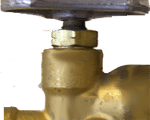 In Australia, BBQ gas bottles must be tested every ten years.
In Australia, BBQ gas bottles must be tested every ten years.
The gas valve is changed upon inspection and the valves are expected to last for the full ten years.
However, occasionally the valve will fail prematurely and start leaking from around the valve stem. This is rare but it can happen.
Bleed Screw
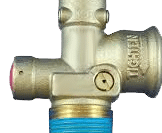 The bleed screw is a small slotted screw on the side of the valve that lets gas vapour bleed off during the decanting refill process.
The bleed screw is a small slotted screw on the side of the valve that lets gas vapour bleed off during the decanting refill process.
The refill technician opens it during the filling process and closes it, when done.
The screw can develop a slow leak if it becomes loose.
Click for the Free Gas BBQ Recipe E-Book Download
New Residential LPG customer?
New Business LPG customer?
Existing ELGAS customer?
- Elgas to the Rescue with Helicopter LPG Delivery - November 14, 2024
- Outdoor Heaters: Outdoor Gas Heaters – Gas Patio Heater Guide - September 22, 2024
- LPG Meaning – LPG Means: What Does LPG Stand For - August 31, 2024
Steve Reynolds
Technical Consultant
Steve Reynolds is a leading expert in the LPG industry with over 22 years of experience. As part of the national management team at ELGAS, Steve ensures the safe and efficient storage, handling, and transportation of LPG. He serves as the lead investigator for incidents and collaborates with authorities on industry developments.
Steve is a technical advisor to Standards Australia and Gas Energy Australia (GEA), and an active member of the World LPG Association (WLPGA), contributing to global standards and technical reviews. He holds a BSc. (Hons) in Industrial Chemistry from UNSW and has held senior safety and technical roles at ELGAS, making him a trusted authority in LPG safety and standards.